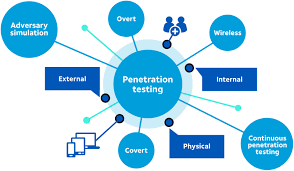Why Your Business Needs Regular Network Penetration Testing
In today's rapidly evolving digital landscape, businesses face an unprecedented array of cybersecurity threats. As technology advances, so do the tactics of malicious actors seeking to exploit vulnerabilities within your organization’s network. This is why regular
network penetration testing is no longer a luxury but a critical component of any comprehensive cybersecurity strategy. In this article, we will delve into the importance of penetration testing and the transformative benefits it offers to businesses of all sizes.
What is Network Penetration Testing?
Network
penetration testing, often referred to as pen testing, and is a simulated cyberattacks
conducted by security professionals to identify vulnerabilities within your IT
infrastructure. This proactive approach involves analyzing networks,
applications, and systems to uncover weaknesses that could be exploited by
attackers.
Types of Penetration Testing
Black Box
Testing: The tester has no prior knowledge of the system, mimicking the
perspective of an external attacker.
White Box
Testing: The tester has full access to the system, including architecture
diagrams and source code.
Gray Box
Testing: A combination approach where the tester has partial knowledge of the
system.
The Critical Importance of Regular Penetration Testing
Ignoring
penetration testing leaves your business vulnerable to cyberattacks that can
have devastating consequences. Below, we explore the compelling reasons why regular
penetration testing is essential.
1. Identifying Security
Vulnerabilities
Penetration
testing helps uncover weak points in your network before malicious actors can
exploit them.
It provides
insights into how attackers might gain unauthorized access, enabling your team
to patch vulnerabilities promptly.
2. Ensuring Compliance with
Regulations
Many
industries are governed by strict cybersecurity regulations, such as GDPR,
HIPAA, and PCI DSS. Regular penetration testing ensures that your business
remains compliant and avoids costly fines.
Auditors
often require evidence of regular security assessments, including penetration
tests, as part of compliance.
3. Protecting Sensitive Data
Data
breaches can compromise sensitive customer and business information, leading to
financial losses and reputational damage.
Penetration
testing simulates real-world attacks, helping you secure data against potential
breaches.
4. Reducing the Risk of Downtime
A successful
cyberattacks can bring your business operations to a halt. Penetration testing
identifies and addresses vulnerabilities that could lead to downtime.
Ensuring
system resilience means uninterrupted service for customers and employees.
5. Enhancing Customer Confidence
Demonstrating
a commitment to cybersecurity reassures customers that their data is safe with
your business.
Regular
testing shows stakeholders and partners that you prioritize proactive security
measures.
Key Benefits of Network Penetration Testing
Investing in
penetration testing yields numerous advantages that go beyond immediate
vulnerability identification.
1. Proactive Risk Mitigation
Identifying
vulnerabilities before they are exploited enables businesses to address risks
proactively rather than reactively.
This
minimizes potential damages and strengthens overall security posture.
2. Cost Savings
While
penetration testing requires an initial investment, it can save your business
substantial amounts by preventing costly breaches and downtime.
Addressing
vulnerabilities early is always more affordable than dealing with the aftermath
of a cyberattacks.
3. Improved Security Policies
Penetration
testing provides valuable insights that inform and enhance your security
policies and procedures.
It
highlights areas where employee training or updated protocols are needed.
4. Real-World Attack Simulation
Penetration
testing offers a controlled environment to simulate real-world attacks, giving
your security team the opportunity to refine their response strategies.
This
readiness reduces the impact of actual incidents.
Common Vulnerabilities Detected Through Penetration Testing
1. Weak Passwords and Authentication
Testing
often reveals poor password practices and vulnerabilities in authentication
mechanisms.
2. Misconfigured Systems
Improperly
configured servers, firewalls, and other systems are common vulnerabilities.
3. Outdated Software
Penetration
testing identifies unpatched software and outdated systems susceptible to known
exploits.
4. Inadequate Network Segmentation
Poorly
segmented networks allow attackers to move laterally within your system once
inside.
How Often Should Penetration Testing Be Conducted?
The
frequency of penetration testing depends on several factors, including the size
of your organization, industry requirements, and changes in your IT
environment. However, as a general rule:
Annually:
Conduct comprehensive testing at least once a year.
After
Significant Changes: Test after major updates, such as system upgrades, new
application launches, or infrastructure changes.
As Required
by Regulations: Follow industry-specific guidelines that mandate testing
frequency.
Choosing the Right Penetration Testing Partner
Selecting a
qualified penetration testing provider is crucial to the success of your
cybersecurity efforts. Look for a partner that:
Has
certified professionals with expertise in ethical hacking and security
assessments.
Offers
detailed reporting with actionable recommendations.
Follows
recognized frameworks such as OWASP and NIST.
Conclusion
Regular network
penetration testing is not just a defensive measure but a strategic
investment in your business's longevity and success. By identifying
vulnerabilities, ensuring compliance, and enhancing security measures,
penetration testing protects your organization from financial loss,
reputational damage, and operational disruptions. Proactively securing your
network ensures that you stay ahead of evolving threats and maintain the trust
of your customers and partners.
.jpeg)
.jpeg)

.jpeg)
Comments
Post a Comment